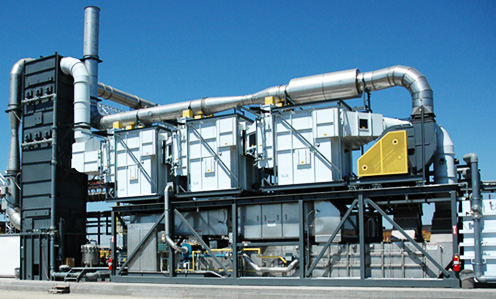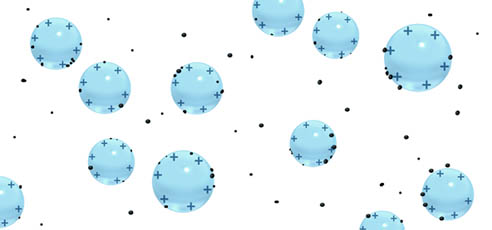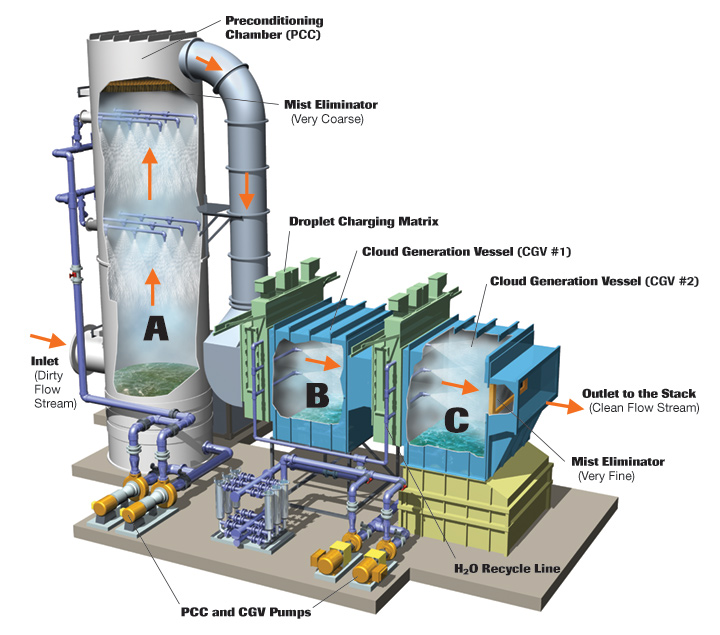Cloud Chamber Fine Particulate Scrubber
Remove submicron particulate & gas pollutants
Tri-Mer Cloud Chamber Fine Particulate Scrubber
CCS wet scrubber technology works by passing the dirty gas stream through a chamber containing a “scrubbing cloud” of high-density, charged water droplets. Inside the wet scrubber, billions of charged droplets rapidly interact with the particles in the process stream. When a particle and a droplet pass within 20 microns, electrical forces cause the particle (being less massive by orders of magnitude) to be pulled into the droplet. Each individual water droplet becomes a particle collector.

How it Works
The droplets collect particles as they interact with the process gas stream, then fall into the sump. Captured particles agglomerate within the sump, settle out, and are removed as a low-volume slurry from the bottom. Relatively clean water from the top of the sump is re-circulated to the charging grid, where it is recharged, completing the cycle.
Recycled and Filtered Water
A low concentration of particulate does not affect the ability to charge the water, so relatively clean water from the top of the sump is filtered for very coarse particles and re-circulated to the charging nozzles.
Consideration Factors
Several factors are involved with optimizing the effectiveness of a particular Cloud Chamber application. These include droplet size, droplet charge, particle size, particle charge, particle retention time, and electric field effect. For each application, a simulation can be run to analyze these factors, along with expected inlet loading, gas type and concentration.
Gases to be treated, if any, are taken into consideration. Simulations help determine the ideal system configuration in terms of recirculation flow, gas-to-cloud contact time, and vessel size. Advanced real time particle measurement is used during start-up to fine-tune parameters.
Applications
- Diesel from ships at port
- Diesel engine test cells
- Diesel from locomotive engines
- Large stationary diesel
- Glass furnace emissions
- Solar panel manufacture
- Abrasive production
- Chemical manufacturing
- Plastics manufacturing
- Sulfuric and nitric acid production
- Many others with submicron PM
- Wet electrostatic precipitator replacement
Pollutants Removed
- Diesel emissions
- Inorganic salts
- Silicon dioxide, silica
- Metal oxides
- Heavy metals
- Ammonium salt particles
- Condensable hydrocarbons
- Combustion byproducts
- Carbonyl sulfide (COS)
- Acid gases such as HCl, HF, H2SO4, HNO3
- Sulfur dioxide (SO2)
- Chlorine gas (Cl2)
- Hydrogen sulfide (H2S)
- Ammonia
Features
Since the charged droplets act as particle collectors, there is no need for fibrous filters, collector plates, venturi throats, layered pads, bags, or cartridges.
Advantages of Cloud Chamber Wet Scrubbers
Particles are, by definition, both solid bits and tiny liquid droplets of condensed pollutants. Size definition for both solid particles and liquid particles has been set by the U.S. EPA as follows:
- Coarse = particles 2.5 micron & larger
- Fine = 2.5 micron &smaller
- Ultra fine particles = 0.1 micron & smaller
Gases usually refers to acid gases and include toxic vapors that can condense into liquid particles. Caustic fumes such as ammonia and its compounds are sometimes called gases.
Coarse particles are easily removed by the CCS wet scrubber. Particles between 0.1 and 2.5 microns are removed at very high efficiencies, often 99% or better. Remarkably, even ultra-fine particles as small as 0.01 micron can be effectively treated after controlled agglomeration growth in the system’s “pre-conditioning” section. On some applications, the CCS can handle inlet mass loadings as high as 2,000 mg/m3, reducing mass emissions to below 5 mg/m3. This is equivalent to 0.9 grains/ft3 reduced to 0.002 grains/ft3.

A Design that Keeps Operating Costs Low
he CCS wet scrubber offers significant operating cost savings. A proprietary, patented method is used to charge the water droplets. The system’s charge generation modules require a maximum of 10 watts of power per 1000 cubic feet per minute (cfm). An ordinary 100 watt light bulb draws as much power as a charging head for 10,000 cfm. Power consumption for charging is usually 1% or less of that required by ESP technology. The key is that only water droplets are charged, and that the charge generating module works under controlled steady-state conditions, putting charge on a highly receptive medium.
The main power draw in a CCS system is the recirculation pumps. The CCS recirculates (but does not consume) more water than wet ESP. The net result, however, is that the CCS still uses substantially less total power to operate. Maintenance costs are also much lower.

Low Operating Cost – Pressure Drop
The wet scrubber chambers are open, with no packing or baffles. Pressure drop is very low, less than 1.5-inch w.g. This results in low fan energy requirements. Most of the pressure drop comes from a mist eliminator at the end of the system and the connecting ductwork. The obstruction-free vessels themselves create nearly zero pressure drop.
Low Maintenance Costs
The open chambers of the CCS reduce typical maintenance problems because there is no fouled packing to clean or biological growth problems to treat. Most importantly, the system has a minimum number of moving parts – only a recirculation pump on each vessel and an ID fan. The charging heads themselves are durable and simple in design.
Application Flexibility
The CCS wet scrubber can be used as a stand-alone unit, or as a tail gas scrubber for existing systems. With the addition of pH adjustment chemicals to the sump liquid, CCS can treat scrubbable gases (such as “ammonia slip” and sulfur dioxide) in addition to fine and ultra-fine particles. Because of the small pressure drop, using the CCS as a tail gas scrubber usually does not require additional fan equipment.


